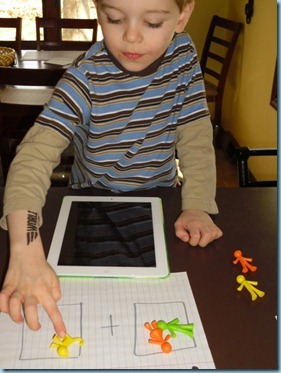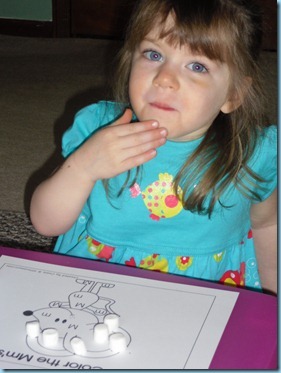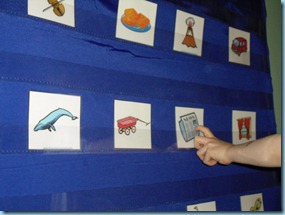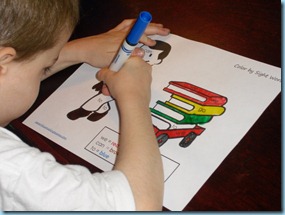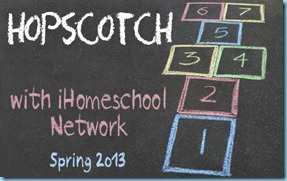About a year ago I wrote a post entitled, “Following the Lead of the Child” and put a request out for other early childhood educators to help me with a post on Developmentally Appropriate Practice in Homeschool. I am excited to share a guest post with you today from Becky {This Reading Mama}. I asked Becky to collaborate with me for this post and am grateful to have another voice here on my blog sharing wisdom about this topic, I hope you find it helpful!
When working with young children, the term "developmentally appropriate" comes to mind quite a bit. The National Association for the Education of Young Children {NAEYC} is the driving force behind the terminology and research. Anyone trained in early childhood education or working in the early childhood field certainly knows this term and is familiar with the NAEYC.
But what about homeschoolers? What about moms who are not trained and have never worked in this environment, but are now teaching their own young children at home? Well, this post is for YOU! I was introduced to the developmental approach while teaching at a Christian preschool. The new director at the time submerged me in all things Montessori. I devoured books, articles, videos, and toured Montessori schools with her. I was amazed at the things I saw and learned. The few years spent getting my M.Ed. in Elementary Reading further fueled my passion towards teaching with a developmental approach. Currently, I’m a homeschooling mom of four, and although no longer in the preschool or elementary classroom, teaching in a developmentally appropriate way drives my instruction at home.
What is Developmentally Appropriate Practice?
"As NAEYC defines it, developmentally appropriate practice (DAP} is a framework of principles and guidelines for best practice in the care and education of young children, birth through age 8. It is grounded both in the research on how young children develop and learn and in what is known about education effectiveness. The principles and guidelines outline practice that promotes young children’s optimal learning and development."
Broken down further, here’s an excerpt from the Key Messages of the DAP Position Statement:
- Developmentally appropriate practice requires both meeting children where they are–which means that teachers must get to know them well–and enabling them to reach goals that are both challenging and achievable.
- All teaching practices should be appropriate to children’s age and developmental status, attuned to them as unique individuals, and responsive to the social and cultural contexts in which they live.
- Developmentally appropriate practice does now mean making things easier for children. Rather, it means ensuring that goals and experiences are suited to their learning and development and challenging enough to promote their progress and interest.
The National Association for the Education of Young Children holds the copyright for the quoted material above.
Developmentally Appropriate Practice at Home
The NAEYC focuses on teaching children in a group setting, but how does this look at home? How do you know that you are teaching your young child{ren} in developmentally appropriate ways?
Here are a few of my thoughts about DAP in the home:
1. Follow the bent and interests of your child. Does your child crave structure and predictability? Does your child prefer using his own creativity as a springboard for learning? Maybe he wants to play all day long, but don’t miss the fact that play is rich with learning. What kinds of books or toys does he naturally gravitate towards? What kinds of questions does he ask you? These will show you what he is interested in learning. Research shows that if a subject is of high interest, the child will be naturally motivated to learn and accept challenges, with your support.
Recently, NJoy {4.5 years old} asked to play a math addition game on our iPad. At first I dismissed the thought, thinking that this game would be too hard for him. But he was extremely persistent, asking me to help him solve these problems {high interest}. I gave him some of our Learning Resources family counters, provided a make-shift addition "mat", and modeled it a couple of times. The look on his face was priceless as he got one after another correct. Any mom with multiple children knows that they are all very different creatures. What works like a charm for one child may be totally rejected by another. The ability to adapt for each child is key! In other words, one size does not fit all.
2. Your child can change from month to month and year to year. What was meaningful and worked one day may not the next. Again, flexibility is important. My daughter {currently 34 months} can be wishy-washy from one moment to the next! Some days, she wants nothing to do with the activities I have planned. But if I become her student in those moments, I am amazed at the things I learn from her. Most days, she wants to do everything her older brothers do; including worksheets or pocket chart games.
3. Your child shows you he is developmentally ready when he uses it, but confuses it. When a child uses a certain concept, but not in the conventional way, it’s HUGE clue that he’s ready to learn about it with your support. Not too long ago, I noticed my daughter was ready to begin learning letter sounds. How? "Mommy, cat starts with M. See mommy? /m/ /m/ cat. See it starts with M. Just like my name." She did this on several occasions with different letters.
So I began working on some letter M activities, emphasizing the letter sound {I’m sure the marshmallows helped: /m/-/m/ marshmallows!}. My son showed me he was ready to do some rhyming activities when he announced in the van one day, "Mommy! Sun rhymes with run and snake." Use, but confuse.
4. Your child displays boredom or frustration. If you’ve stepped out of the "zone" of developmentally appropriate, your young child will let you know! If he seems bored with the activity, it may be because it’s too easy for him. If she is frustrated and gives up, chances are you’re asking her to do something too hard for her. Children operating in their "zone" {also known as their instructional level or ZPD} are typically engaged and active participants in their own learning. Teaching in the "zone" means 1- the child has a basic understanding and interest in the activity and 2-it is just enough of a challenge for the child that he cannot do it by himself, but can do it with your help.
For example, my son knew all his letter sounds by 42 months. He asked to do schoolwork, like his big brother. So I developed a PreK reading curriculum for him called Reading the Alphabet that we’re working through this school year.
Anything on a Kindergarten level would have been too fast-paced and frustrating, but reviewing letters and their sounds for another year would have been dry and dull {for him and for me}. I created something to take him a step deeper, into his "zone".
5. The age {or grade level} of your child is not the only predictor of what is developmentally appropriate for him. While the age of your child can help you make general predictions about what he should learn, his own development has to be taken into consideration. It reminds me of a 3rd grader I knew confused her b’s and d’s when she wrote. The mom had been told by a well-meaning friend that her daughter should not be doing this anymore because, after all, she was in the 3rd grade. When I asked the mom a few questions, I discovered her daughter was reading and writing at a 1st grade level. Letter reversals are still very common in the 1st grade; so developmentally speaking, the child was doing exactly what writers do in that stage. Was it still an area of concern? Of course! But acknowledging the child’s developmental stage in regards to literacy was vital because it revealed more about her than age or grade level alone.
6. Developmentally Appropriate Practice goes well beyond academics. Anything {brushing teeth, riding a bike, getting dressed, etc.}, if taught outside of your child’s developmental zone, can be a source of frustration for you and your child. One of the practices I learned from developmental teaching is gradually releasing responsibility to the child. This means modeling and teaching in the zone {see #4} with lots of support; then gradually "releasing" the child to do it independently, with less support as she goes.
What are Some Next Steps Moms Can Take?
- Pray. Ask God to help you see your child as He does. God knows your child better than you. Ask him for wisdom in teaching this gift He has given you.
- Humble yourself. Sometimes, it’s easy to get wrapped up in pride {ask me how I know}. When that lovely printable I’ve created is rejected by my son or daughter, it stings. When Suzy’s daughter is younger than mine, yet can already read; I begin to compare myself as a mother. Don’t go there.
- Play. Take time to simply be your child’s mom instead of "teacher". Enjoy spending time with your child without a pre-planned agenda. You’ll be surprised at the things your child will teach you! Some of my favorite teaching ideas have come from playing with my children.
Developmentally appropriate practice is attainable for homeschooling moms of young children, even without formal training and experience. Many times, it’s as simple as becoming students of our children to see the whole picture. Instead of asking them to get into our neat, little prepackaged "box" of teaching, we need to unwrap their "box" to find the true treasures…their interests, their bent, and their zone. It’s what developmentally appropriate practice is all about.
 Becky Spence is a homeschooling mama to four little blessings. She is passionate about teaching, specifically literacy. She is the author of This Reading Mama, where she shares reading and writing activities as well as free literacy curricula and printables. You can connect with her on Facebook, Twitter, Pinterest, and Google +.
Becky Spence is a homeschooling mama to four little blessings. She is passionate about teaching, specifically literacy. She is the author of This Reading Mama, where she shares reading and writing activities as well as free literacy curricula and printables. You can connect with her on Facebook, Twitter, Pinterest, and Google +.
This post is #3 in my series, “Homeschooling Tots & Preschoolers,” for the iHomeschool Network Spring 2013 Hopscotch. Visit other bloggers participating here!
Day 1 ~ Where to Begin with Tot School eBook
Day 2 ~ You Don’t Have to Do it All!
Day 3 ~ Developmentally Appropriate Practice
Day 4 ~ Time Invested in Tot Schooling
Day 5 ~ 10 Tips for Studying Nature with Tots
Day 6 ~ Exposure vs. Mastery
Day 7 ~ Why Themes?
Day 8 ~ Teaching Tots in a Large Family
Day 9 ~ Our Favorite Learning Tools for Tots
Day 10 ~ Early Childhood Theme Printables A-E


